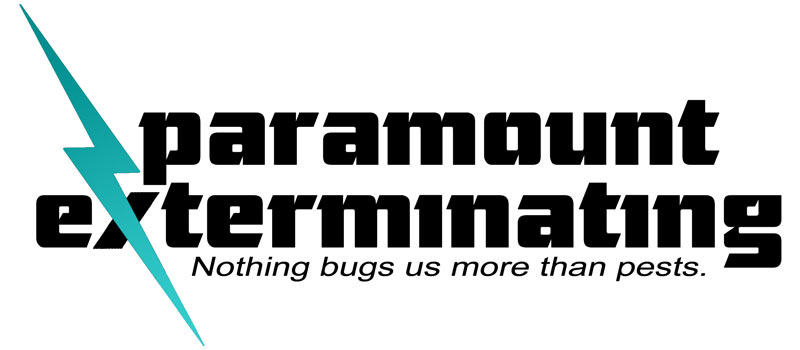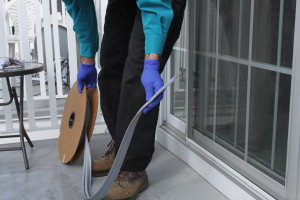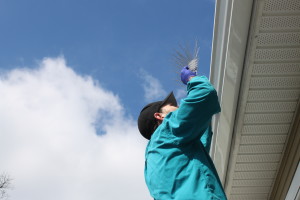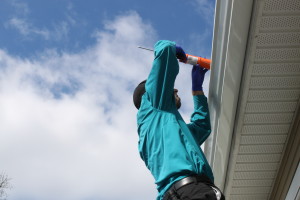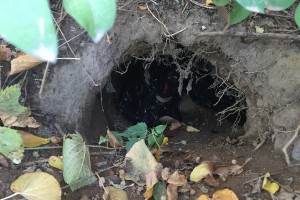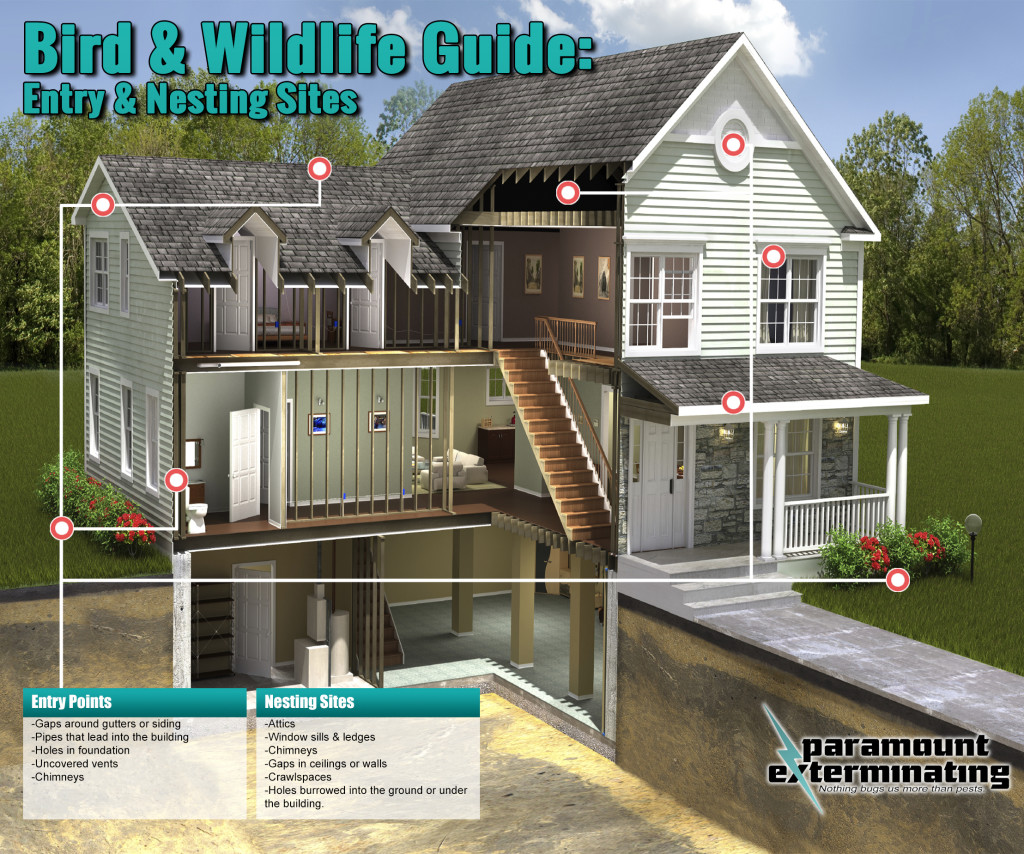CALL US TODAY! 800-273-6050
REQUEST YOUR FREE ESTIMATE
HUMANE ANIMAL & BIRD REMOVAL
 Total animal/bird control – Our staff members are highly knowledgeable in animal & bird habits, biology, and control methods. In emergency situations, we are able to remove animals quickly and humanely. With chronic problems, like pigeons roosting, we create a removal and prevention strategy based on the biology of the bird/animal that continues to work. Our experience gives us the upper hand in making sure the problem doesn’t return.
Total animal/bird control – Our staff members are highly knowledgeable in animal & bird habits, biology, and control methods. In emergency situations, we are able to remove animals quickly and humanely. With chronic problems, like pigeons roosting, we create a removal and prevention strategy based on the biology of the bird/animal that continues to work. Our experience gives us the upper hand in making sure the problem doesn’t return.- Long-term Protection – Our staff members can create a prevention strategy that helps keep animals and birds away from your property for all year around.
- Closures/Structural Modifications – Your technician will find any entry points and suggest closure methods. We can even perform closures and structural modifications if necessary.
CALL US TODAY!
NJ Toll Free
800-273-6050
Newark
973-242-2212
Rutherford
201-945-7066
Jersey City
201-435-5900
Ridgewood
973-423-0234
Union City
201-865-7799
BIRDS & WILDLIFE FACTS
PEST BIRDS
Although it may seem harmless to let birds do as they please, often times these pest birds are causing damage to buildings, losses to surrounding businesses, and health threats to the public. Birds can harbor disease, leave behind corrosive droppings, and even attract mites into your home or business! Their feces is often seen on signs, billboards, awnings, window sills, and can be a major deterrent for potential home-buyers or customers. Their droppings are expensive to clean and can cause staining and even permanent damage to siding, brick, stucco, and other building materials!
Pest bird habits differ with each species, and can vary depending on the season, environment, and migration patterns. When dealing with pest birds, we recommend having a trained professional inspect the area and fully assess the problem. Birds can often be difficult to identify, and without knowledge of their habits, they can be nearly impossible to remove completely. Our trained professionals will determine the species of bird and the best course of action based on that species habits, food sources, and migration patterns.
HUMANE WILDLIFE CONTROL
Environment: Wildlife pests are generally outdoor animals like squirrels and racoons. These animals can be a nuisance and cause property damage and lose of business among other problems. Wildlife pests may enter the home if the conditions are right, especially squirrels and birds that enter buildings to stay warm and nest during the winter months.
Health/Damage Concerns: These pests can cause property damage to roofs and siding, lawn damage and can lead to business loses and constant cleaning and repair bills.
Home Remedies: The best home remedy for controlling wildlife pests is exclusion; preventing them from getting in inside in the first place. This often means sealing up gaps around pipes indoors and outside, putting mesh over gutters, and sealing up any cracks in the foundation of the building, among other things. This can be a difficult task, but it will be worth-while in preventing unwanted pest entry.
Humane Animal Control: At Paramount Exterminating we strongly believe in HUMANE ANIMAL AND WILDLIFE CONTROL. This means exclusively trapping and releasing animals back into the wild, or finding them a shelter. This is done to protect our furry and feathered friends from harm, as well provide you with peace and comfort. Animal releases are done far away from any populated areas in a state sanctioned release area. We are kind to animals, you should be too!
WHAT TYPE OF BIRD IS IT?
 One of the most common pest birds in urban areas, Pigeons are well adapted to living among humans and have become a nuisance since they were first introduced in the to US in the 1600’s. Their fearless nature allows them to nest in areas that other birds may not consider like on air conditioning units, window sills, building ledges, and in the attics of homes. They are also highly adaptive to changes in their environment and do not often migrate, making it difficult for home or business owners to get rid of them. Often when a Pigeon creates a nest it will attempt to stay at this sight unless physically removed or excluded from the area, and even then it will most likely make several attempts to reclaim the area. The uric acid in their feces is highly corrosive and causes millions of dollars in repair costs across the country every year. Females lay an average of 3 eggs at a time, having as many as four batches of offspring a year. The eggs generally take 2 to 3 weeks to hatch, with young leaving the nest as early as a month after being born.
One of the most common pest birds in urban areas, Pigeons are well adapted to living among humans and have become a nuisance since they were first introduced in the to US in the 1600’s. Their fearless nature allows them to nest in areas that other birds may not consider like on air conditioning units, window sills, building ledges, and in the attics of homes. They are also highly adaptive to changes in their environment and do not often migrate, making it difficult for home or business owners to get rid of them. Often when a Pigeon creates a nest it will attempt to stay at this sight unless physically removed or excluded from the area, and even then it will most likely make several attempts to reclaim the area. The uric acid in their feces is highly corrosive and causes millions of dollars in repair costs across the country every year. Females lay an average of 3 eggs at a time, having as many as four batches of offspring a year. The eggs generally take 2 to 3 weeks to hatch, with young leaving the nest as early as a month after being born.
 Appearance: Despite the variety of Canadian Geese sub-species, they are all very similar in appearance. Geese are large birds, generally varying in size from two to three feet long, with brown or grey colored bodies and black colored necks and feet. Their beaks are also dark in color, with white markings on either side of the face.
Appearance: Despite the variety of Canadian Geese sub-species, they are all very similar in appearance. Geese are large birds, generally varying in size from two to three feet long, with brown or grey colored bodies and black colored necks and feet. Their beaks are also dark in color, with white markings on either side of the face.
Habit: Geese are generally migrating birds, traveling to warmer climates when the weather gets cold, but urbanization is changing that. Geese are now more frequently staying in one location year-round, adapting to the much simpler lifestyle with no issue. Areas like country clubs and golf courses are being plagued by these large birds due to the abundance of edible grass, foliage, and bodies of water. These locations provide Geese with a perfect home where they have available food year-round. The mild winters that we have had in the recent past have also allowed these birds to stay in one location without the need to migrate. This has led to a great increase in the number of Geese in the state of New Jersey, making them a common nuisance at residential homes, commercial businesses, on college campuses, and at sports complexes. Geese generally nest near bodies of water, especially those with nearby foliage which they use as both a food source and protective area. Geese are also aggressive, especially when it comes to protecting an area that they consider to be theirs. As a result, humans and animals alike have been attacked or harmed by them as a result of getting too close to their nesting sites or young.
Health/Damage Concerns: Geese can cause damage in a variety of ways, from trampling and eating crops, to damaging lawns and attacking people and animals they consider predators. While the structural and monetary damage created by pigeons usually out ways that of Canadian Geese, the damage to people lawns and commercial properties are in-measurable. They are also known to damage water sources like lakes, ponds, and reservoirs with their feces, and are one of the leading birds responsible for aircraft-bird collisions around the world.
Diet: Plants and vegetation; they primarily feed on available grasses and foliage that are found near their nesting area.
Reproduction: Geese mate during a month long mating season that takes place during the Spring. A female will generally lay one egg every two days. Geese are monogamous for their entire lives, unless their mate dies, at which point they will seek out another mate.
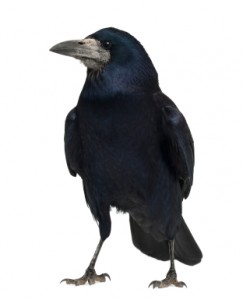 Appearance: The common crow native to New Jersey is a large, black bird measuring 16 to 20 inches in length with a relatively short bill for its body size. Its coloring is completely black from bill to claws, with a slightly purple or greenish-blue gloss on its body and wings. A crow’s eye color actually changes over time with the young having blue eyes and adults having black eyes.
Appearance: The common crow native to New Jersey is a large, black bird measuring 16 to 20 inches in length with a relatively short bill for its body size. Its coloring is completely black from bill to claws, with a slightly purple or greenish-blue gloss on its body and wings. A crow’s eye color actually changes over time with the young having blue eyes and adults having black eyes.
Habit: Crows are known for their increased level of intelligence, making them very difficult to control or remove. They are highly social birds that are in constant communication with the rest of their flock. Crows in our area often migrate south during the winter months depending on weather conditions. Crows in areas further south do not need to migrate.
Health/Damage Concerns: A variety of health and damages concerns get raised when dealing with crows. The uric acid in their droppings poses not only a health risk, but also poses the risk of damage to buildings, roofs and siding. This type of damage adds up over time and costs millions of dollars a year in repairs around the country. Crows can also be aggressive in protecting their nesting areas causing concern for people that need to travel nearby. They are also an agricultural nuisance since they are notorious for attacking crops, especially corn.
Diet: Scavenger diet; will eat anything from freshly planted crops to small animals (snakes, mice, ect.) and carrion. They are also known to eat a variety of insects, making them a federally protected bird.
Reproduction: Female crows with often have one to two broods per year with four to seven eggs in each brood. It only takes about two months for young to go from egg to young bird ready to leave the nest.
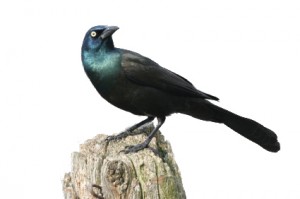 Appearance: Grackles are mostly black in color, with an iridescent sheen that varies from purple to green. They vary in size according to the particular species, but the ones generally seen in our area are about 12 inches in length. The grackles common to New Jersey and the north east coast are called Boat Tailed grackles, having to do with their V-shaped tails that crease during flight.
Appearance: Grackles are mostly black in color, with an iridescent sheen that varies from purple to green. They vary in size according to the particular species, but the ones generally seen in our area are about 12 inches in length. The grackles common to New Jersey and the north east coast are called Boat Tailed grackles, having to do with their V-shaped tails that crease during flight.
Habit: These birds are notorious for being very noisy and aggressive. They tend to gather in large numbers making them quite a nuisance for both residential neighborhoods and commercial properties. They are most often seen near the coastline, only rarely are they seen venturing further inland. During the winter months, Grackles in the north east will migrate south in search of warm weather and a plentiful food source.
Health/Damage Concerns: Due to their habit of gathering in large numbers, Grackles can cause lots of damages to all types of properties. Not only is the uric acid in the feces corrosive and unsanitary, they are also aggressive and loud, scaring away potential customers and people just trying to walk near their nesting/feeding sight.
Diet: Scavenger diet; feeds on human food scraps and agricultural crops.
Reproduction: The breeding season for Grackles is during the Spring. Females will generally have one brood per year, laying an average of four to five eggs per brood. The incubation period lasts for only two weeks, and young are able to fly in as little as three weeks. Nesting sites are often built in trees, but they are also fond of nesting in areas of dense vegetation and in marsh lands.
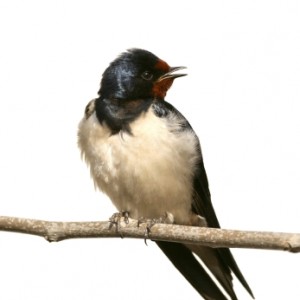 Appearance: Both Cliff and Barn Swallows are similar in appearance, with bold blue coats, lightly colored bellies, and reddish-brown faces. Young Swallows are the same color as adults but with a duller finish on their coats. The difference between cliff and barn swallows lies in the look of their tails. Barn swallows have forked tails, while cliff swallows have square shaped tails.
Appearance: Both Cliff and Barn Swallows are similar in appearance, with bold blue coats, lightly colored bellies, and reddish-brown faces. Young Swallows are the same color as adults but with a duller finish on their coats. The difference between cliff and barn swallows lies in the look of their tails. Barn swallows have forked tails, while cliff swallows have square shaped tails.
Habit: Swallows are very territorial in nature and will always attempt to return to the same nesting sight year after year. They are well known for their migration patterns, spending the summer months in North America and the winters in South America.
Health/Damage Concerns: Swallows are a protected species. Due to their habit of gathering in large numbers, Swallows can cause lots of damages to all types of properties. Not only is the uric acid in the feces corrosive and unsanitary, they can also harbor parasites and mites.
Diet: Insectivore; swallows feed on many types of insects, but more commonly feed on large flies and small insects hovering over the surface of a body of water. They are commonly seen drinking and bathing themselves by flying over a water source and quickly diving in as they are flying. Flying ants are also a favorite of swallows.
Reproduction: Both of the common species of swallows have two broods per year. Each brood contains four to five eggs. The eggs take around two weeks to hatch, with young leaving the nest after only three to four weeks.
Control Methods: Swallows are protected under the law and may not be disturbed once they have laid eggs. Nest removal must wait until the winter months when they have migrated south. Once a nest is removed, preventative fencing using mesh netting is required to prevent them from rebuilding a new nest in the same area.
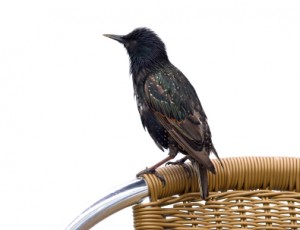 Appearance: European Starlings are small, muscular birds that average 18 to 24 centimeters in length. Their bodies are dark in color, with an iridescent sheen and white or yellow speckles. They are generally distinguished from other blackbirds by their long and narrow bills and short, stubby tails. During the summer months Starlings coats become a duller finish and have fewer speckles.
Appearance: European Starlings are small, muscular birds that average 18 to 24 centimeters in length. Their bodies are dark in color, with an iridescent sheen and white or yellow speckles. They are generally distinguished from other blackbirds by their long and narrow bills and short, stubby tails. During the summer months Starlings coats become a duller finish and have fewer speckles.
Habit: Starlings are well known for their aggressive behavior towards other birds. They often flock in huge numbers, sometimes in the tens of thousands, and use their numbers to force native birds out of their homes. This has caused concern among environmentalists and the US Department of Agriculture who fear that the abundance of these birds limits and restricts other native bird species from thriving. Starlings are also well adapted to living in urban areas where food sources are plentiful.
Health/Damage Concerns: Starlings, like most birds, can cause extensive damage to homes and commercial buildings. Nests are often found in hard to reach places like gutters, under roof eaves, and inside of buildings. The droppings of the Starling are also high in uric acid content causing both cosmetic and structural damages to a variety of building types. Often these droppings will remove or permanently stain paint, stain siding, and damage roofing shingles. Nests found in building gutters have been directly linked to extensive water damage over time, and nest created inside of buildings and machinery have been linked to electrical fires and equipment damage. Their presence also poses health risks from bacteria, fungus spores, and fecal parasites.
Diet: Various food sources; they eat a wide variety of foods including insects, berries, seeds, fruits, and human scraps.
Reproduction: Two broods per year, with an average of four to five eggs per brood. The incubation period for European Starlings is short, only lasting twelve days with young leaving the nest only three to four weeks after hatching. Starlings mate during the spring months.
 Appearance: Small in size, the Sparrow is well adapted to the urban environment. Their short but strong beaks are perfect for breaking open seeds and feeding on left behind food scraps. Male Sparrows can be identified by their darkly colored throats, lightly colored cheeks and brown wings. Female Sparrows are mostly brown in color with the darker colored stripe next to their eyes.
Appearance: Small in size, the Sparrow is well adapted to the urban environment. Their short but strong beaks are perfect for breaking open seeds and feeding on left behind food scraps. Male Sparrows can be identified by their darkly colored throats, lightly colored cheeks and brown wings. Female Sparrows are mostly brown in color with the darker colored stripe next to their eyes.
Habit: Sparrows are often seen flocked together in large numbers in urban areas. Due to the lack of predators and their ability to adapt to living and nesting in urban environments, they have become the number two nuisance bird behind feral pigeons. They prefer nesting sites that are small and enclosed if possible, including areas like pipe ends, behind shutters, building gutters, and in gaps under roof eaves. Sparrows are very well adapted to living among humans and will often feed on human food scraps. This makes them detrimental in manufacturing areas as they will often arrive in very large numbers to scavenge for food. Sparrows are intelligent and aggressive, forcing other bird species out of their homes and making them difficult to get rid of. This is made worse by the fact that they roost in very large numbers, making a Sparrow problem even more difficult to remove. They are also non-migratory birds, typically staying in the same nesting area all year long unless under extreme environmental changes. Sparrows in rural settings will sometimes travel to more urban areas for the winter months in search of slightly warmer city temperatures and to find nesting sites inside of buildings.
Health/Damage Concerns: Sparrows, like most birds, can cause extensive damage to homes and commercial buildings. Nests are often found in hard to reach places like gutters, under roof eaves, and inside of buildings. The droppings of the Sparrow are also high in uric acid content causing both cosmetic and structural damages to a variety of building types. Often these droppings will remove or permanently stain paint, stain siding, and damage roofing shingles. Nests found in building gutters have been directly linked to extensive water damage over time, and nest created inside of buildings and machinery have been linked to electrical fires and equipment damage. Their presence also poses health risks from bacteria, fungus spores, and fecal parasites.
Diet: Scavenger/seed eater. Sparrows will eat a variety of foods depending on what is available in the general area of the nesting site. Preferred foods include seeds, small insects, and human food scraps.
Reproduction: Sparrows, on average, have about 15 to 20 young per year. This is because most females have four to seven young at a time, about three times per year. An unchecked Sparrow problem can result in large numbers of birds being born in only a one to two year period.
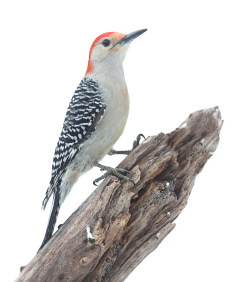 Appearance: Averaging six to fourteen inches in length. Most species have black and white plumage, with males also having red markings on their heads. They have short legs and stiff tails that allow them to perch vertically on the sides of trees and buildings.
Appearance: Averaging six to fourteen inches in length. Most species have black and white plumage, with males also having red markings on their heads. They have short legs and stiff tails that allow them to perch vertically on the sides of trees and buildings.
Habit: Usually found in wooded areas, the Woodpecker gets its common name from “pecking” at the sides of trees and buildings. They do this for several reasons, but mainly to carve out a shelter in the branch of a tree or the side of a wood building, or to find food hiding inside of the wood. Generally they will choose to carve their nesting site in the side of the tree or building that gets the most sun in the morning and during the day. Woodpeckers are usually non-migratory and can survive on the food they find underneath tree bark and in rotten wood. These are areas that most birds cannot get access to, leaving the Woodpeckers food supply unchallenged.
Health/Damage Concerns: Woodpeckers are protected by the Federal Migratory Bird Treaty Act. Woodpeckers can cause damage to homes and commercial buildings by pecking any structure made of wood.
Diet: Woodpeckers feed on insects found underneath the bark of trees and hidden in dead wood. They are able to use their beaks to peck out insects that normally would be inaccessible. Some species also feed on ground dwelling insects, nuts, and berries.
Reproduction: Woodpecker breeding takes place during the spring months. Females generally have two broods per year with two to eight eggs per brood.
 Appearance: Seagulls are a well-known bird along the New Jersey shore. They generally have white or light colored feathers on their bodies, with darker colored wings and very dark wing tips. Wing color can range from light grey to dark black. Young seagulls are darker in color, usually dark grey to brown.
Appearance: Seagulls are a well-known bird along the New Jersey shore. They generally have white or light colored feathers on their bodies, with darker colored wings and very dark wing tips. Wing color can range from light grey to dark black. Young seagulls are darker in color, usually dark grey to brown.
Habit: Gulls are intelligent birds that are not bothered by human presence. They are commonly seen hovering over bodies of water, garbage dumps, and other areas that have an ample food supply. Gulls have a special gland above their nostrils that removes salt from drinking water allowing them to consume both fresh and salt water. They are also strong swimmers and are fast movers on land as well.
Health/Damage Concerns: Gulls are Federally Protected Birds! Seagulls, like most birds, can cause extensive damage to homes and commercial buildings. Their droppings are high in uric acid content causing both cosmetic and structural damages to a variety of building types. Often these droppings will remove or permanently stain paint, stain siding, and damage roofing shingles. Their presence also poses health risks from bacteria, fungus spores, and fecal parasites. Gulls are also notorious for their involvement in midair collisions with small and large aircraft.
Diet: Scavenger diet; they will feed on almost anything edible, including from fish, garbage, mice, insects, and human scraps.
Reproduction: Seagulls are ground nesters that seek undisturbed locations like sand dunes to lay their eggs. Their nests are commonly sparse, normally consisting of a few sticks and a variety of grasses. Seagulls do not have many young, only producing an average of three eggs per year in one brood. The incubation process takes place over three weeks, with young ready to leave the nest only six weeks after hatching. Seagulls breed during the Spring months.
WHAT TYPE OF ANIMAL IS IT?
 Name: Sciuridae (family)
Name: Sciuridae (family)
Appearance: Averaging 9 to 12 inches in length, covered in grey, brown, or black colored fur. They are identifiable by their large, bushy tails and the white color of their bellies.
Habit: The squirrel most common in northern New Jersey is the Eastern Grey Squirrel (Sciurus carolinensis). They are well-known for their dare-devil attitude and are often seen leaping from tree branch to tree branch. In the wild, they commonly live in hollowed out opening in trees, but they also thrive in urban environments by using people attics and garages as nesting sites. They use their sharp teeth to chew holes in the exterior of a building in order to find harborage inside. They are most active during early evening and early morning hours of the day. Some species are nocturnal and are rarely seen during the daylight hours.
Health/Damage Concerns: They can cause damage to roofs, siding, screens, gutters, chimneys, and other building materials by chewing and nesting.
Diet: Scavenger diet; will eat insects, tree bark, nuts, seeds, plant buds, fruit, leaves, etc. They are also known to store food when it is not immediately needed as a winter reserve.
Reproduction: The eastern grey squirrel generally has two litters of young per year, with 3 to 4 young per generation. This usually occurs during the early spring and again in the late summer months.
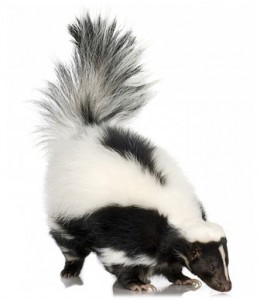 Name: Mephitus mephitis (Striped Skunk), Spilogale putorius (Spotted Skunk)
Name: Mephitus mephitis (Striped Skunk), Spilogale putorius (Spotted Skunk)
Appearance: Commonly black and white in color and about the same size as a house cat. Coloring, markings, and size vary by species, the most common species being the stripped and the spotted skunk. They have long claws on their front feet used for digging.
Habit: Skunks are well known for their odor. This odor is used as a defense mechanism to help the skunk avoid predators, and is generated by two internal glands near the base of the animal’s tail. The liquid that is discharged can reach up to 20 feet and can be discharged multiple times. Humans and animals that are sprayed can carry the odor around with them for long periods of time, and if sprayed in the eyes, can result in temporary blindness and pain. Skunks often like to hide underneath building foundations and porches by digging with their long front claws. This provides them with a low traffic, unexposed hiding place. Skunks are relatives of the weasel, and are within the same family.
Health/Damage Concerns: Skunks can be a serious health concern. They are known to carry disease and are the second highest cause for rabies transfer behind the raccoon. They also cause property damage, damage to gardens and crops, and harm to poultry and livestock. They are also well known to damage beehives and feed on both adult and larval stage bees.
Diet: Omnivore/Scavenger; eats small ground animals like moles, rats, mice, and shrews, along with garden vegetables, insects, and insect larvae.
Reproduction: Skunks commonly mate in the late winter months in time to give birth to offspring in the early summer. Reproductive frequency is dependent on the species, but doesn’t happen more than twice a year. Skunks do not hibernate, and are active all year, but will often hide out for several weeks in situations of extreme cold.
 Name: Opossum (Didelphidae)
Name: Opossum (Didelphidae)
Appearance: Opossums can vary in size from a few inches to a few feet depending on its age, with adult averaging about 2 feet in length from nose to tail. They are commonly silver, black, or grey in color and have hairless tails that are used for grasping and balancing on branches. They also have an opposable claw on their back feet that allows them to move quickly and carefully along tree tops. Opossums are actually marsupials and relatives of the kangaroo. Females are equipped with a pouch typical of a kangaroo in which they protect their young.
Habit: Opossums are nocturnal animals that thrive in unexposed areas like underneath home foundations, porches, or anywhere that stays dark and is low-traffic. They are not hard workers however, never actually digging their own burrows, but always looking to move into abandoned ones. They also like to live right near their food source so that they have easier access and little traveling to do. Opossums are also well known for “playing dead” or “playing possum.” When confronted by a predator, the adult opossum’s instinctual reaction is to pretend it is dead to deter the attacking animal. This is not a controlled reaction however, and is more akin to fainting than actually playing dead. They opossum will lay stiff on the ground for up to four hours while excreting a foul smell from its anal gland to produce a “sick” or decaying type odor to further deter the predator.
Health/Damage Concerns: Opossums are well known to carry disease and are one of the most prolific animals in the spread of rabies. Behind wild dogs, they are the most notorious for spreading the virus despite the fact that it is estimated that only 1 in every 800 opossum actually carry the virus.
Diet: Omnivore/Scavenger diet; Opossum’s are actually quite beneficial as they feed on small pests like mice, slugs, insects, and dead animals. However, they will also eat garden fruits and vegetables, birds, and garbage, making people’s homes a perfect spot to search for food. This can often lead to knocked over garbage cans and damaged lawns as they search for grubs and small insects to feed on.
Reproduction: Females can give birth to many young at once, but only have the capacity to feed up to thirteen offspring. Opossum young are born about the size of a bee, and are nurtured inside of the mothers pouch. Once old enough, the young then begin to travel on the mothers back, as they are not old enough to be on their own but can no longer fit inside of the pouch.
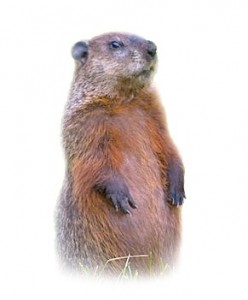 Name: Ground Hogs (Marmota monax)
Name: Ground Hogs (Marmota monax)
Appearance: Averaging 16 to 30 inches in length and 5 to 30 lbs. in weight, a groundhogs size and weight can be drastically different at various times of the year. This is because ground hogs hibernate during the winter months and survive on their stored body fat. They are at their peak size and weight just before winter hibernation, and are much thinner when they emerge several months later. Groundhogs have short, yet powerful limbs and thick claws that are perfectly shaped for digging. They also have short tails that only measure about 1/4th their body size, and two coats of hair. Their undercoat is thick and colored grey, while their outer guard hairs are often white, giving the groundhog an almost prickly appearance.
Habit: Groundhogs are well known for their ability to dig, and frequently create large burrows for hiding, sleeping, nurturing young, and hibernating. An average groundhog will remove several hundred pounds of dirt in the process of digging its burrow, and will create multiple entrances/exits to be used as escape routes if threatened. They are also known to dig separate burrows for hibernation, which are dug below the frost line, so that they can stay warm underground for the cold winter months. Groundhogs are strong swimmers and climbers, and will often climb tree to escape predators. They are also known to defend their burrows from predators and other groundhogs with their curved claws and large front teeth.
Health/Damage Concerns: Groundhog burrows can reach up to 5 feet deep and 40 feet long, with multiple exit holes that can severely damage lawns, plants, and crops. They are also a hazard for people and farm machinery, as their holes can cause personal injury to occur and damage to farm and lawn equipment. Further, their burrows can cause damage to buildings by compromising the buildings foundation.
Diet: Herbivore; eats grasses and variety of vegetation including food crops. They derive their water source from eating plants that hold lots of moisture, rather than directly drinking water. They will also eat small ground insects and certain types of nuts if present.
Reproduction: Groundhogs generally breed from March to April, shortly after the completion of their hibernation process. Females produce an average of 2 to 6 young at a time that will stay with their mother for five to six weeks. The newborns are hairless and blind, and must be protected by the mother for at least a month. Once the young are covered in hair and no longer blind, the young are encouraged to enter the wild by the mother.
BIRD & ANIMAL LOCATION GUIDE
– Find out where to look for Birds & Animals –
Why Families and Businesses Choose Paramount
- Faster Service – Get your services scheduled quickly and on YOUR time. No one wants to wait weeks for treatment, and we get that.
- Local and Reliable – We have pest control technicians in Union City, Jersey City, Hoboken, Weehawken, North Bergen, and Hudson County everyday to assist our customers at a moments notice!
- More Efficient – We get things done right the first time, saving you time, money, and frustration.
- Better Tools – Our technicians only use the best products available on the professional market making treatments more effective and longer lasting.
- Better variety of treatment methods – Including green treatments and baiting programs.
- More Experience – We’ve been defeating all types of pests since 1930, and have the most experienced technicians in the industry.
HOURS OF OPERATION
Monday – Friday: 8am – 4pm
Saturday: 8am – 2pm
Sunday: Closed
• 24-Hour Emergency Service Available •
• Free Evaluations •
Proudly Serving Jersey City, West New York, Guttenberg,
Hoboken, Weehawken, Secaucus, & All of Hudson County
CALL US TODAY
Union City, NJ Rutherford, NJ Ridgewood, NJ
(201) 865-7799 (201) 945-7066 (973) 423-0234
Newark, NJ NJ Toll Free Jersey City, NJ
(973) 242-2212 (800) 273-6050 (201) 435-5900
